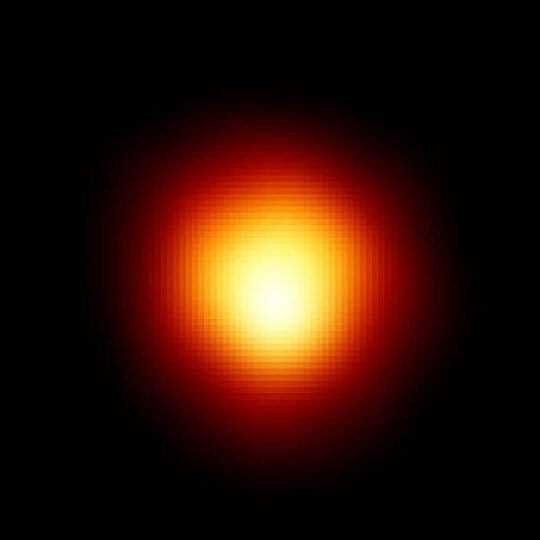Experts have proposed several hypotheses regarding the origin of red stars. The most likely explanation suggests that these blue stars were once part of a binary system, which eventually merged. When two stars merge, a new star is formed with increased brightness, mass, and temperature.
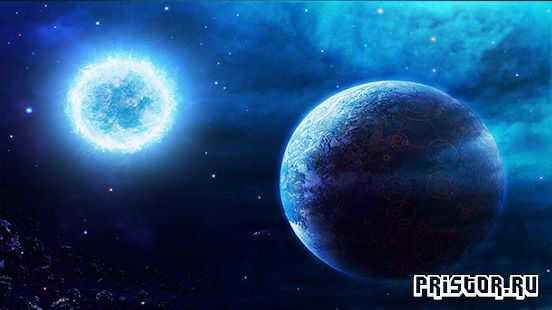
Examples of blue stars:
- Gamma Sails;
- Rigel;
- Zeta of Orion;
- Alpha Giraffe;
- Corma Zeta;
- Tau of the Big Dog.
Stars that are white in color are known as white stars
A particular scientist made a remarkable find of a faint white-colored star which is a companion to Sirius and it was given the name Sirius B. This extraordinary star has a surface temperature of 25000 Kelvin and has a relatively small radius.
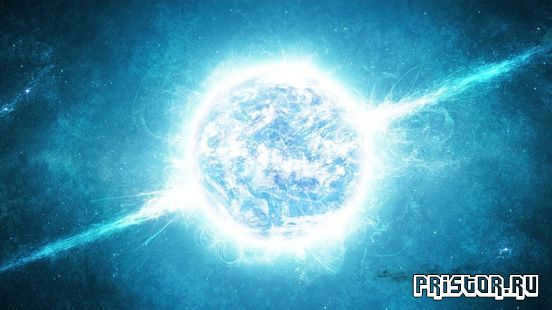
Examples of stars that are white in color:
Stars that are colored yellow are known as yellow stars
These stars emit a yellow-colored light and their mass falls within the range of the Sun’s mass, which is approximately 0.8-1.4. The surface temperature of these stars typically reaches a temperature of 4-6 thousand Kelvin. A star of this type has a lifespan of around 10 billion years.
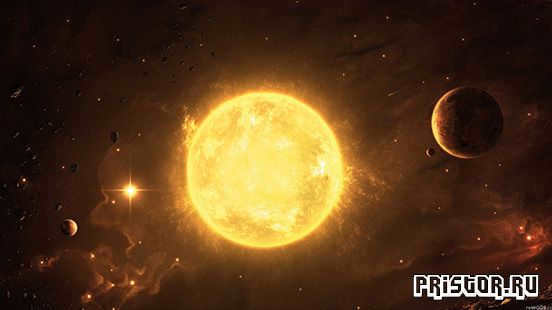
Examples of yellow stars:
Stars of a red hue are red stars
The first red stars were discovered in 1868. They have a relatively low temperature, and the outer layers of red giants contain a significant amount of carbon. In the past, these stars belonged to two spectral classes – N and R, but scientists have now identified another common class – C.
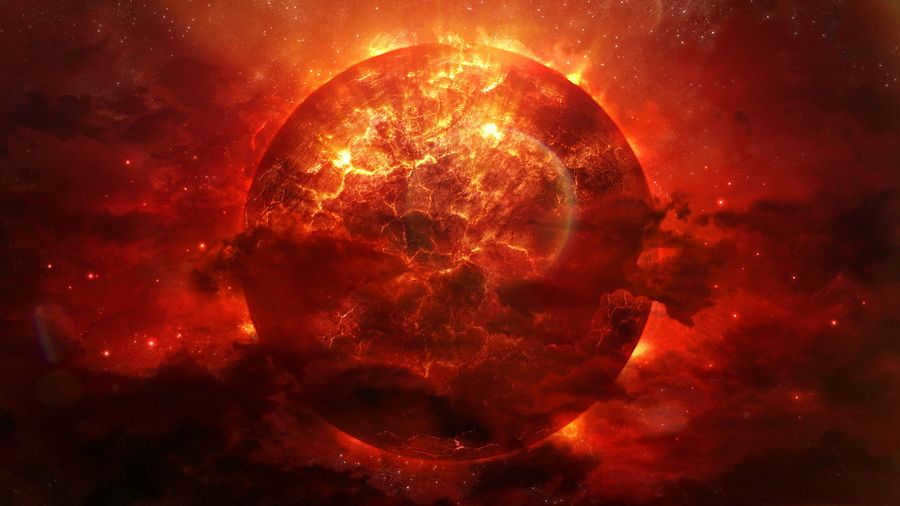
Examples of red stars:
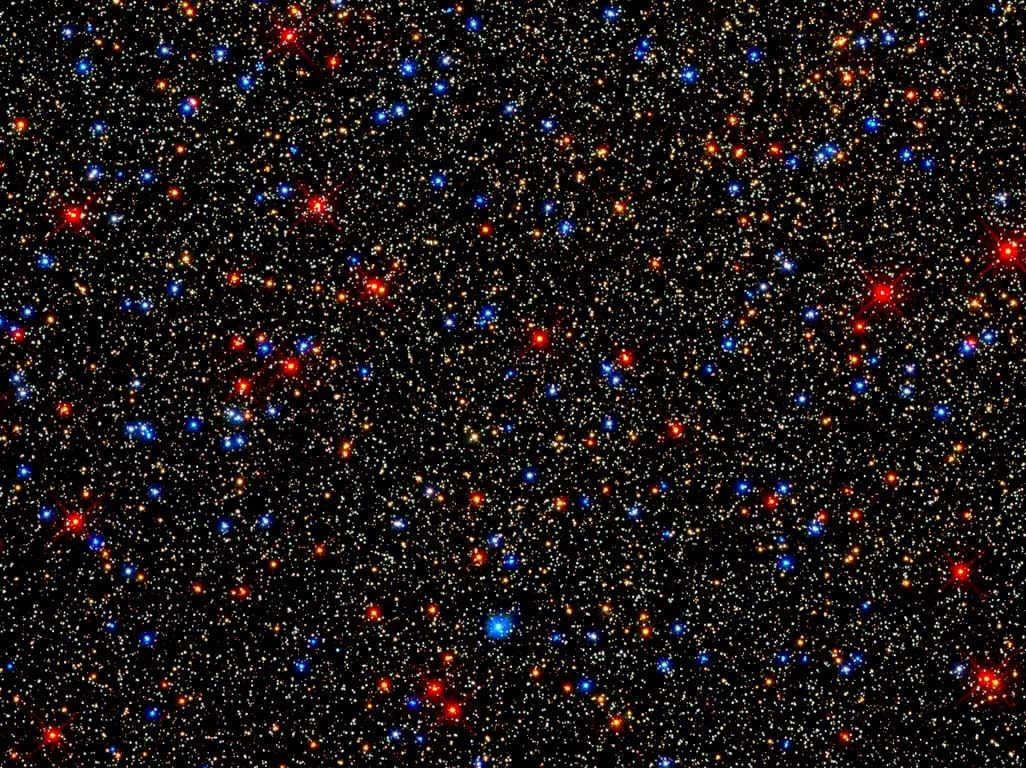
The variety of colors displayed by stars is vast. From blue and white to yellow and red, these shades can even be observed through the Earth’s atmosphere, which often distorts the appearance of celestial objects. However, the question remains: what is the origin of a star’s hue?
The Origin of Stellar Colors
Understanding the vibrant colors of stars has become a crucial tool for astronomers, as it allows them to determine the temperature of a star’s surface. This phenomenon is rooted in the fascinating relationship between the energy of matter and the color of light it emits.
You may have already noticed this yourself through simple observations. For example, the filaments of low-power 30-watt bulbs emit an orange glow, which turns into a faint red when the voltage decreases. Stronger bulbs emit a yellow or even white light. Meanwhile, a welding electrode and a quartz lamp emit a blue light, although it is important to note that observing these sources directly can be harmful to the retina due to their intense energy.

As a result, the color of an object’s glow is closer to blue the hotter it is and closer to dark red the colder it is. This principle also applies to stars. The color of a star is influenced by its composition, but this influence is minimal as the temperature can ionize certain elements, making them difficult to detect.
However, by analyzing the color spectrum of a star’s radiation, we can determine its composition. Each substance has its own unique range of wavelengths. Some colors of light pass through unimpeded, while others are blocked. In fact, scientists can identify chemical elements by the specific ranges of light that are blocked.
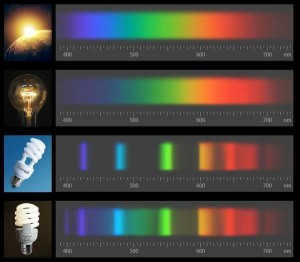
Emission spectra of various light sources
The process of star “coloring”
What is the scientific explanation behind this phenomenon? Temperature is related to the speed at which molecules in a substance move – the higher the temperature, the faster they move. This affects the length of light waves that pass through the material. A hot medium shortens the waves, while a cold medium lengthens them. The visible color of a light beam is determined by the length of its wavelength: shorter wavelengths correspond to blue tones, while longer wavelengths correspond to red tones. White color is achieved by combining multiple spectral rays.
The color of a star is a significant factor in multiple stellar classification systems simultaneously. It serves as the primary criterion for determining a luminary’s spectral class. Since color is closely linked to temperature, it is graphed on one of the axes of the Hertzsprung-Russell diagram. This diagram also provides valuable and visual information about a star’s luminosity, mass, and age.
If you found this post interesting, feel free to share it with your friends!
The red giant phase occurs following the main sequence phase in a star’s lifecycle. When a star depletes its nuclear fuel, it expands to hundreds of times its original size and cools down, causing it to appear red in color.
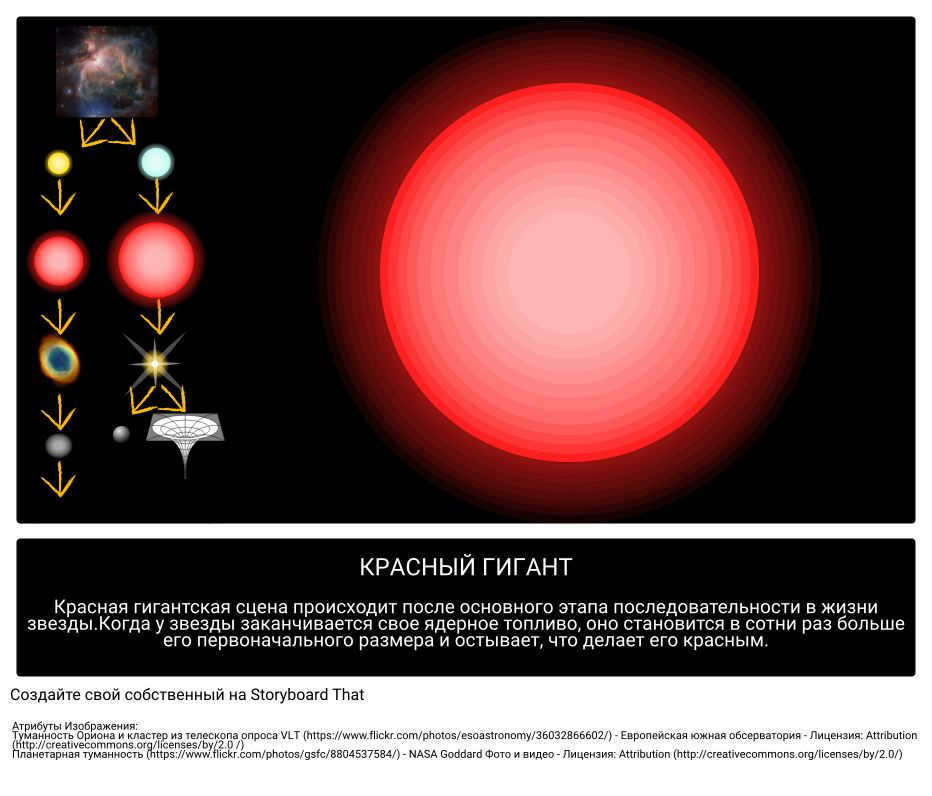
Red giant star
A red giant is a type of star that has reached the end of its main sequence. The red giant phase is the initial stage in the final phase of a star’s life cycle. The term “red giant” is derived from the fact that these stars are larger than main sequence stars and emit a greater amount of red light. The change in color is due to the cooler surface temperature of the expanded star, giving it an orange or red hue.
Stars go through the red giant stage once they have depleted hydrogen in their cores, resulting in the fusion of hydrogen or other elements in the surrounding region. This alters the balance between the pressure from nuclear reactions and the gravitational force that keeps the star intact. As a result, the star’s outer layers expand, increasing its size. Eventually, when the fuel is exhausted and the nuclear reactions cease, the star perishes.
In approximately five billion years, when our very own Sun enters the red giant phase of its lifecycle, it will expand to engulf the orbits of both Mercury and Venus. Even if the Earth manages to avoid being devoured by the Sun, the increased radiation emitted by the red giant will lead to the complete vaporization of all life on our planet.
The various stages in the life cycle of a star
(a star with a mass similar to that of our Sun)
- A stellar nebula
- Main-sequence star
- Red giant star
- Planetary nebula
- White Dwarf
- Black Dwarf
Stages of the Life Cycle of Massive Stars
- Stellar Nebula
- Main Sequence Massive Star
- Red Supergiant Star
- Supernova
- Neutron Star (or Black Hole)
Notable Examples of Red Giants
- Mira (Omicron Ceti)
- Betelgeuse (Alpha Orionis)
- Aldebaran (Alpha Tauri)
- Antares (Alpha Scorpii)
- Arcturus (Alpha Boytis)
![<\displaystyle 0^</p>
<p><ul>[ZEBR_TAG_/p></p><p><li>https://ru.wikipedia.org/wiki/ÐÑаÑнÑй_гиганÑ</li></p><p><li>http://crydee.sai.msu.ru/~mir/Star_Life.site/Evolution/HR_diagram/rg.htm</li></p><p></ul></p><p>\geq M_\geq -3^>” width=”” height=””></p><p>Convective processes can cause the transfer of nucleosynthesis products from the star’s internal nuclear sources to its atmosphere, resulting in the observed anomalies in the chemical composition of red giants, specifically the heightened carbon content.</p><p>Red giants have an average density that is a million times lower than water (for comparison, the Sun has an average density roughly equal to water, 1 g/cm3). However, the ratio of average density to core density can be as high as 1:108 (compared to the Sun’s ratio of about 1:50). Approximately 10% of a red giant’s mass is made up of its small core, where thermonuclear reactions occur, while the majority of the star’s mass is in a large shell that carries the energy from the core to the surface.</p><p>When red giants expand and increase their radius, the acceleration of free fall on their surface becomes significantly reduced. For example, if a star with a mass equivalent to that of the Sun transforms into a red giant and expands to the size of the Earth’s orbit, the acceleration of free fall would be as low as 0.0006 <i>g</i>. In contrast, the acceleration of free fall on the surface of the Sun is 27.8 <i>g</i>. This significant decrease in surface gravity, combined with the star’s high luminosity, makes it more likely for matter to be lost from its outer layer.</p><h2>Nuclear Power Sources and Their Connection to the Structure of Red Giants</h2><p>As main-sequence stars evolve, they undergo a process known as hydrogen depletion, where hydrogen is converted into helium through nucleosynthesis in the <i>pp</i>-cycle and, in the case of massive stars, the CNO cycle. This depletion causes helium to accumulate in the star’s central regions, where it remains at temperatures and pressures too low for thermonuclear reactions to occur. The lack of energy release in the stellar core leads to compression, resulting in increased temperature and density. This increase in temperature and density triggers a new source of thermonuclear energy: helium depletion through the <i>triple helium reaction</i> or <i>triple alpha process</i>. These processes are characteristic of red giants and supergiants.</p><p>The majority of 8 Be, which has a half-life of only 6.7 × 10 -17 seconds, decays back into two alpha particles, but the collision of 8 Be with a high-energy alpha particle can result in the formation of a stable 12 C carbon nucleus:</p><p>Despite the extremely low concentration of Be 8 at equilibrium (e.g., at a temperature of approximately 10 8 K, the ratio of 8 Be to 4 He concentration is about 10 -10 ), the rate of the triple helium reaction seems to be sufficient to achieve a new hydrostatic equilibrium in the star’s hot core. The energy release in the ternary helium reaction is highly dependent on temperature: thus, for temperatures in the range of <i>T</i> ≈ 1-2×10 8 K, there is a significant release of energy.</p><p>As a result, their luminosity increases and a helium flash occurs with a duration of approximately 10 4 -10 5 years.</p><p>It should be emphasized, nonetheless, that the triple helium reaction exhibits a significantly lower energy output compared to the CNO-cycle: when considering energy output per unit mass, the energy released during helium “burning” is more than 10 times less than during hydrogen “burning”. As helium is consumed and the nuclear energy source is depleted, more intricate nucleosynthesis reactions become feasible. However, these reactions necessitate increasingly higher temperatures and the energy output per unit mass in such reactions diminishes as the mass numbers of the nuclei participating in the reaction increase.</p><h2>Final phases in the development of red giants [ ]</h2><h2>The Sun in the form of a red giant [ ]</h2><p>The Sun is presently a star in its prime, having an estimated age of about 4.57 billion years. The Sun will continue to exist on the primary sequence for approximately 5 billion more years, slowly elevating its luminosity by 10% every billion years, until the hydrogen in its core is exhausted.</p><p>Following this, the temperature and density within the core of the sun will experience a significant rise, leading to the ignition of helium and its subsequent transformation into carbon. As a result, the size of the sun will expand by a factor of at least 200, nearly reaching the orbit of our present-day Earth (0.93 a.u.) [3] [4] [5]. Moreover, despite the sun’s substantial mass loss during its transition into a red giant, both Mercury and Venus will ultimately be engulfed and completely vaporized by the expanding sun. If the Earth does not share the same fate, it will become so intensely heated that any possibility of life surviving will be eradicated [6] [7]. Additionally, the oceans will evaporate long before the sun reaches the red giant stage, occurring approximately 1.1 billion years from now [8].</p><p>After about 100 million years, the Sun is expected to stay in the red giant phase. Eventually, it will transform into a planetary nebula with a white dwarf positioned at its core. The planetary nebula will disperse into the interstellar medium within a few thousand years, while the white dwarf will gradually cool over billions of years.</p><h2>Variable stars: a closer look at red giants</h2><h2>Related resources</h2><h2>Further reading</h2><h2>Additional notes</h2><ol><li>↑ This commonly used term refers to the position of red giants within a range of spectral classes, rather than their age.</li><li>↑ Zeilik, Michael A.; Gregory, Stephan A. (1998). <i>Introductory Astronomy & Astrophysics</i> (4th Ed. ed.). Saunders College Publishing. pp. 321-322. ISBN0-03-006228-4.</li><li>↑Red Giants. HyperPhysics (hosted by the Department of Physics and Astronomy of Archived from the original source on February 5, 2012.</li><li>↑<i>Strobel, Nick</i>Stages 5-7. <i>Lives and Deaths of Stars</i> (June 2, 2004). Checked December 29, 2006.Archived from the original source on February 5, 2012.</li><li>↑The fading: red giants and white dwarfs. Archived from the original source on February 5, 2012.</li><li><a href=](/wp-content/uploads/images/kakie-zvezdy-krasnogo-cveta_1.svg)
Formation – – Main sequence – – Asymptotic branch of giants – – – Planetary nebula – – Bright blue variables – Wolf-Raye star – – Supernova star – – Hertzsprung-Russell diagram
List of star names – – – List of largest stars – – List of nearest stars – List of brown dwarfs – Chronology of stellar astronomy
Highlight Red Giant and find in:
- Around the worldgiant address
- Akademikgiant/en/ru/en/address
- Astronetaddress
- Elementsgiant+&search address
- Scientific Russiagiant&mode=2&sort=2 address
- Krugosvetgiant – address
- Scientific Network
- Tradition – address
- Cyclopedia – address
- Wikknowledge – giant address
- Bing
- Yahoo
- Yandex
- Mail.ru
- Rambler
- Nigma.RF
- Sputnik
- Google Scholar
- Aport
- Online translator
- Internet Archive
- Popular science movies on Yandex
- Documentary films
- List of wikis
- Wikis in Russian
- List of large Russian-language wikis
- Directory of wiki sites
- Russian-language wiki projects
- Wikiznanie:Directory of wiki sites
- Popular science sites on the Internet
- Explore the top popular science websites on our platform
- Discover the best popular science sites
- Find a directory of science websites
- SCIENCE IN THE RUNET: A comprehensive catalog of scientific and popular science sites
- Page 0 – a brief article
- Miscellaneous page – on pages: Please share your insights in the “Reader Comments: [ ]” section
The night sky is a breathtaking sight, captivating us with its vibrant array of lights. As we gaze up, we can admire stars of various hues, including blue, red, and yellow. Have you ever wondered about the distribution of colors among stars?
The surface temperature plays a significant role. The Sun’s temperature is a scorching 6,000 Kelvin. Interestingly, the Sun is actually white in color, but when observed from Earth, it appears yellow due to the light passing through our atmospheric filter. If the temperature were cooler, the light would appear red, and if it were hotter, it would appear blue. The diagram below illustrates the correlation between stellar temperature and color, showcasing the various hues of stars.
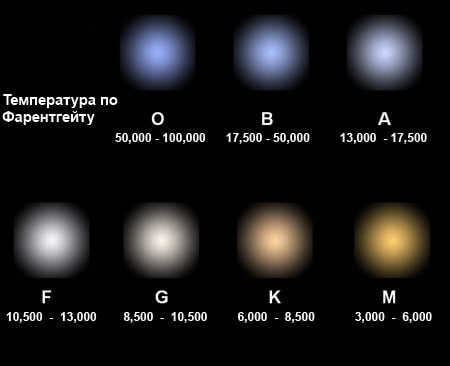
The color of a star depends on the temperature of its surface.
Therefore, it is understood that red dwarfs are the coldest stars. Their mass can only reach 7.5% of the solar mass, and their temperature is 3500 Kelvin. Although they have various colors, the most dominant one that our eyes perceive is red.
Red giants also have a red color. These stars have the same mass as the Sun, but they have consumed all their hydrogen and have started expanding in size. As a result, their luminosity spreads over the larger surface area and the temperature decreases.
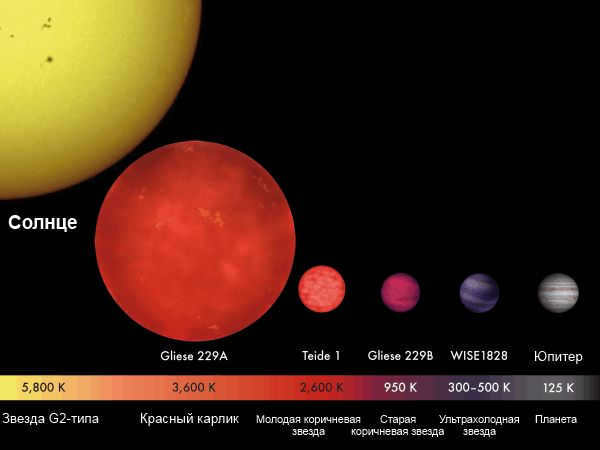
The coldest stars are characterized by a low surface temperature.
Blue stars, on the other hand, are the hottest celestial bodies, with temperatures ranging from 10000 Kelvin to as high as 40000 Kelvin for hypergiants. Understanding the various colors of stars allows us to classify different types of celestial bodies.
Classification of star colors
The colors of stars vary greatly. Typically, we observe white and red stars in the night sky.
Contrary to popular belief, stars are not exclusively white. They can be blue, yellow, orange, and red.
Their radiant glow in the sky is a fascinating and enigmatic spectacle.
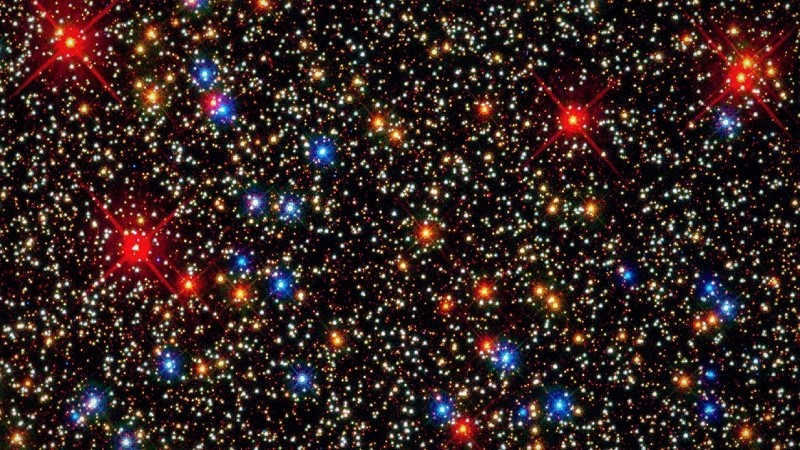
Different colored stars
Reasons for the different colors of stars
To begin with, the Earth’s atmosphere causes the true colors of stars to appear distorted.
Furthermore, the perception of stellar radiation as white is primarily influenced by our human capabilities. This is because the retina in our eyes contains receptors responsible for color vision. In low light conditions, we are able to see more clearly with weaker impulses.
Interestingly, the diverse colors of stars are not primarily determined by their composition, but rather by their temperature. It turns out that heating ionizes specific elements, which in turn affects their visibility.
By analyzing the spectrum, astronomers can ascertain the makeup and heat of celestial entities. This is because each substance has its own unique range of wavelengths. For instance, specific substances allow certain light waves to pass through easily, while others do not. Hence, the composition of the object can be deduced in this manner.
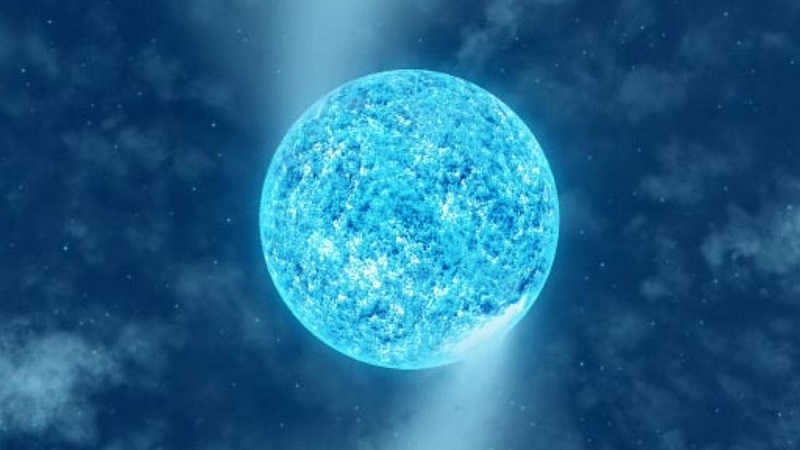
Naos (the hottest star)
Regardless, the variation in hues is determined by the surface temperature. It is worth mentioning that there is always a correlation between energy and emitted light in nature.
In actuality, the degree of heating is influenced by the velocity of molecular movement within the substance, which in turn affects the wavelength of light passing through said substances. In other words, when molecules move at a higher speed, the surface becomes hotter and the wavelengths become shorter. Conversely, a colder medium is characterized by slower molecular movement and elongated wavelengths.
It turns out that visible light that is emitted consists of light waves. The shorter waves are seen as blue, while the longer waves are seen as red. When different spectral rays are combined, white light is produced.
Remember that the Hertzsprung-Russell diagram displays the key features of stars, which are interconnected. From the diagram, we can observe that the colors of stars vary based on their temperature, with the colors ascending in order.
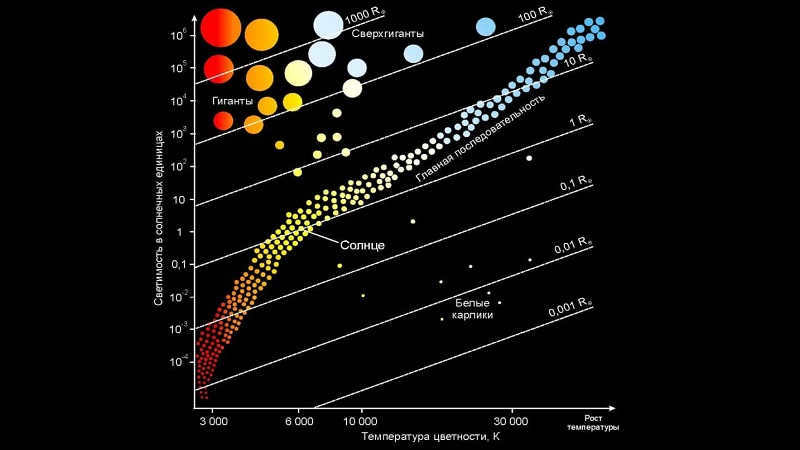
The Hertzsprung-Russell diagram.
What is the color of cool stars?
In actuality, the surface temperature of cool stars can reach up to 3,000 degrees Celsius. These stars appear red in color and are typically classified as red giants.
What is the color of the hottest stars?
Interestingly, the hotter a star is, the closer its color is to blue on the spectrum. The temperature of these stars can range from 10,000 to 30,000 degrees Celsius, with some reaching temperatures of about 100,000 degrees. These extremely hot stars are classified as blue giants.
Stars Classification by Color
First and foremost, stars are classified based on their color, following the principle of temperature, from hottest to coldest. There are a total of seven groups, each further divided into categories ranging from 0 to 9.
Class O: Blue Stars
Class O stars are known for having the highest temperatures, averaging around 300,000 degrees Celsius. They are often the result of binary stars merging, resulting in a single, extremely bright and massive star with intense heat.
Some examples of Class O stars include Rigel, Tau of the Big Dog, and Orion’s Zeta. These stars are considered to be quite rare in our Universe.
Class B: white and blue
Mostly, these are small celestial bodies with surface temperatures ranging from 7,000 to 200,000 C.°C. This category includes stars like Altair, Vega, and Sirius.
G class yellow.
A yellow star has a surface temperature of around 60,000°C and has a mass similar to that of the Sun (0.8-1.4).
Some notable examples of this category are the luminaries Alhita, Dabich, Capella, among others. Additionally, our very own Sun belongs to the G2 dwarf class.
Orange dwarfs belong to the K class.
What sets them apart from other stars is their temperature, which ranges from 4,000 to 60,000°C. One well-known orange star is Aldebaran.
Red dwarfs fall into the M class.
Unlike other stars, their surface temperature is not as hot (30,000°C), and they have a carbon-rich outer shell. Many famous celestial objects fall into this category, such as Antares and Betelgeuse.
Interestingly, orange and red stars are the most common in the Universe.
What are the different hues of celestial bodies?
On one hand, there is a peak in the spectrum that corresponds to a specific color. However, this is not always apparent to the naked eye. The light may appear white or even reddish. In order to truly understand the properties of celestial objects, a thorough analysis of the intensity distribution of electromagnetic radiation is required. Fortunately, many telescopes now have the capability to differentiate between these colors.
Furthermore, we have developed the ability to identify other forms of radiation, which allows us to learn more about cosmic bodies.
For instance, it has been discovered that neutron stars emit X-rays. There are also celestial bodies that emit green and violet light, which we perceive as white and blue, respectively. However, these colors can only be observed with specialized instruments, as they are typically found in very close double systems.
Therefore, we have obtained knowledge regarding the hue of the celestial stars and the factors contributing to their variation. It is our hope that you are now equipped to provide an answer to the inquiry: what is the specific color of a star such as Betelgeuse?
It is important to bear in mind that when engaging in observation, one should not overlook the fact that a star emitting a solitary light may, in actuality, possess a distinct spectrum.
Distinguishing Stars by Color: Examples of Multicolored Stars
Blue Stars – The Enigmatic Blue Giants
Experts have proposed multiple theories regarding the origin of blue stars. The most plausible explanation suggests that these blue stars were once part of a binary system that underwent a merging process. When two stars merge, a new star is born, exhibiting significantly greater brightness, mass, and temperature.
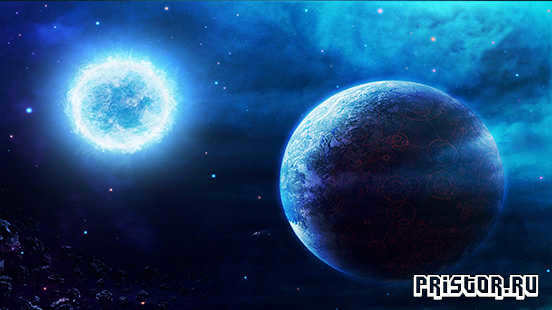
Examples of blue stars:
White stars are stars that appear white in color
A scientist found a faint white star that orbits around Sirius, which was named Sirius B. This extraordinary star has a surface temperature of 25000 Kelvin and a small radius.
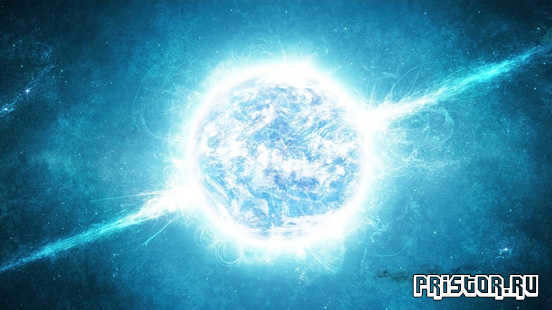
Examples of stars that are white:
Stars that have a yellow color are known as yellow stars
These stars emit a yellow-colored light and their mass falls within the range of the Sun’s mass, which is approximately 0.8-1.4. The surface temperature of these stars typically reaches 4-6 thousand Kelvin. A yellow star has a lifespan of around 10 billion years.
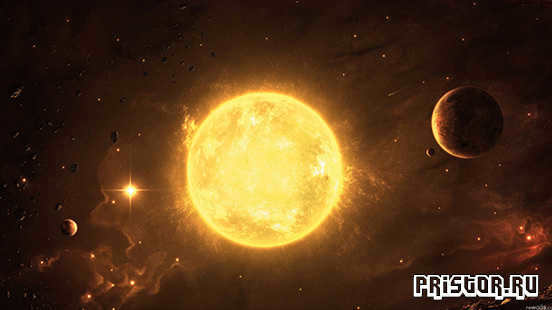
Examples of yellow stars:
Stars that are red in color are known as red stars
The first red stars were discovered in 1868. They have a relatively low temperature, and the outer layers of red giants contain a significant amount of carbon. Previously, these stars were classified into two spectral classes – N and R, but scientists have now identified another common class – C.
It is a common misconception that all the stars in the sky are white in color. (Except for the Sun, which is, of course, yellow..) Surprisingly, the reality is quite the opposite: our Sun is actually white, and stars can be found in a variety of colors – ranging from bluish and white to yellowish, orange, and even red!
Another interesting question arises: can we perceive the color of stars with our naked eyes? Dull stars appear white simply because they lack the intensity to stimulate the cones in our retinas – the specialized cells responsible for color perception. The rods, which are more sensitive to low light levels, are color blind. This is why in the darkness, both cats and stars appear to be gray.
The brilliant hues of shining stars
Take a moment to explore the constellation of Orion, specifically focusing on its two most luminous stars, Rigel and Betelgeuse. (Orion is the prominent constellation of the winter sky, visible in the southern hemisphere from late November to March.)
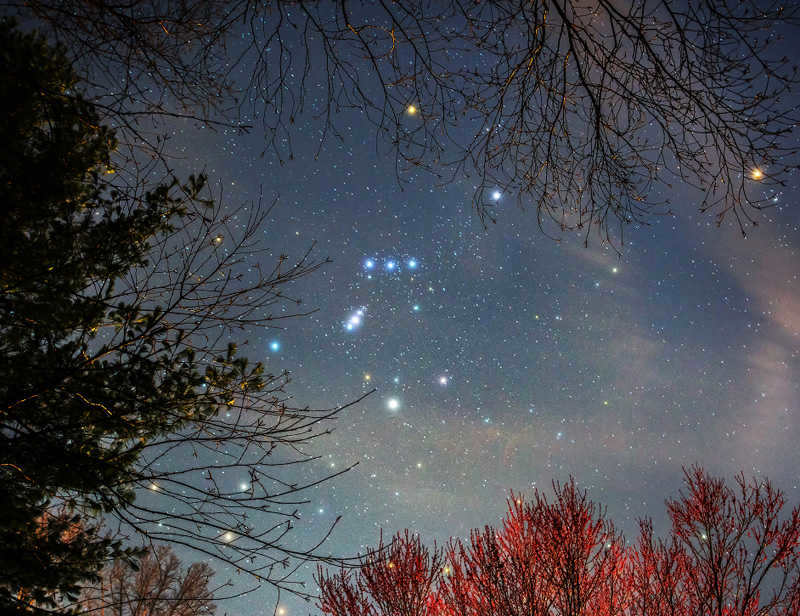
Among the stars in the constellation Orion, Betelgeuse stands out with its distinctive reddish hue. Photo: Bill Dickinson/APOD
It is evident from a quick glance that Betelgeuse appears red, while Rigel appears bluish-white. This is not an illusion – the stars genuinely possess different colors. The variation in color is solely determined by the temperature on the surfaces of these stars. White stars have higher temperatures compared to yellow stars, and yellow stars, in turn, have higher temperatures than orange stars. The hottest stars have a bluish-white appearance, while the coolest stars have a red hue. Consequently, Rigel is significantly hotter than Betelgeuse.
What is the true color of Rigel?
Occasionally, things are not as straightforward as they may seem. On a chilly or blustery evening, when the atmosphere is turbulent, an intriguing phenomenon can be observed – Rigel undergoes rapid changes in brightness (in simpler terms, it flickers) and displays an array of colors! It shimmers with various hues! At times, it appears blue, at other times it appears white, and every now and then, a hint of red emerges! Thus, Rigel is not a blue-white star after all – its actual color remains a mystery!
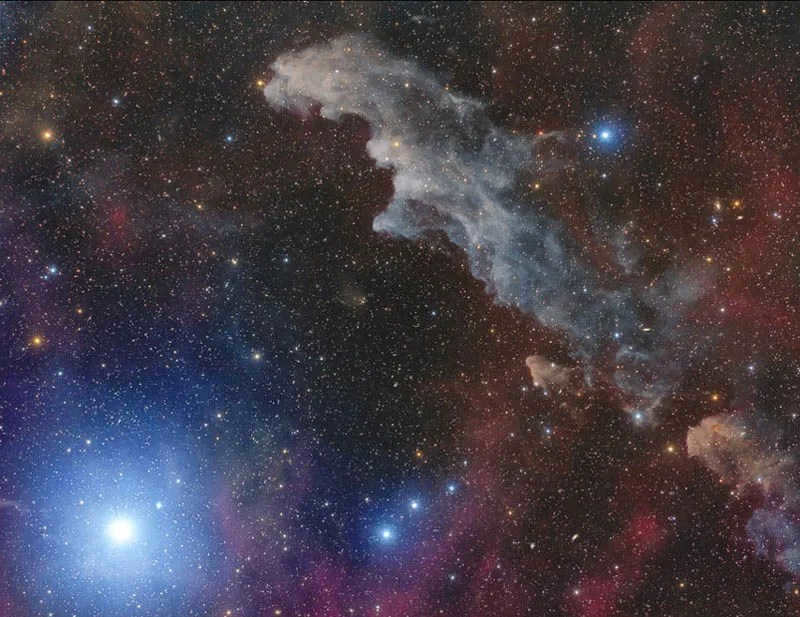
Blue Rigel and the Witch’s Head reflection nebula. Photo: Michael Heffner/Flickr.com
This phenomenon is entirely caused by the Earth’s atmosphere. When stars are low above the horizon (and Rigel never rises high in our latitudes), they often twinkle and shimmer with various colors. The light from these stars has to pass through a thick atmosphere before it reaches our eyes. During this journey, the light is refracted and deflected by layers of air with different temperatures and densities, resulting in the shimmering effect and rapid changes in color.
A prime example of a star that shimmers with different colors is the white star Sirius, which can be found in the sky near Orion. Sirius is the brightest star in the night sky, making its twinkling and rapid color changes much more noticeable compared to its neighboring stars.
While there are stars in various colors, the human eye has the ability to differentiate between white and reddish stars most easily. Among all the bright stars, it is possible that only Vega has a noticeable blue hue.
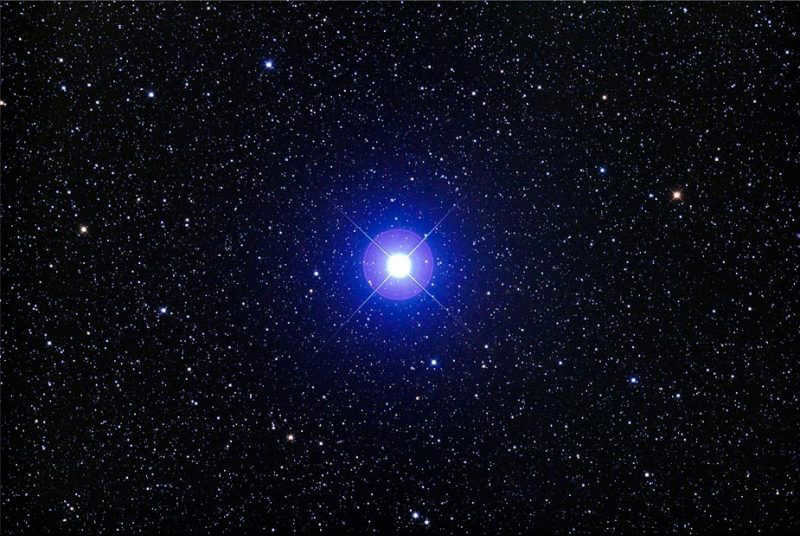
What colors do stars have when observed through telescopes and binoculars?
When observed through optical instruments such as telescopes and binoculars, stars display a much wider and brighter range of colors. These colors include bright orange, yellow, bluish-white, yellowish-white, golden, and even greenish hues. It is important to note that while most of these colors are real, green stars do not exist in nature. The appearance of greenish and emerald green stars is an optical illusion, although a very beautiful one. The illusion occurs when observing close double stars, where a yellow or yellowish-orange star is in close proximity.
A refractor telescope is less accurate in color reproduction compared to a reflector telescope because refractor telescopes suffer from chromatic aberration to some extent, while reflector mirrors reflect light of all colors equally.
It is quite fascinating to observe stars with multiple colors first with the naked eye and then with either binoculars or a telescope. (When observing through a telescope, it is recommended to use the lowest magnification available.)
The table presented below displays the colors of 8 bright stars. The brightness of these stars is indicated in stellar magnitudes. The letter v denotes that the star’s brightness is variable – it shines with varying intensity for physical reasons.
Multicolored stars illuminating the December night sky
In the month of December, a fascinating array of twelve brilliantly hued stars can be seen. We have previously discussed the vivid red hue of Betelgeuse and the bluish-white brilliance of Rigel. On exceptionally serene nights, the pure whiteness of Sirius captivates the observer. The star known as Capella, located in the constellation of Ascendant, may appear predominantly white to the naked eye, but upon closer inspection through a telescope, it unveils a distinctive yellowish tint.
Make sure to direct your gaze towards Vega, which can be observed during the evening hours from August until December, positioned high in the southern sky and later transitioning towards the west. Vega is rightfully referred to as the celestial sapphire, as its blue coloration, when viewed through a telescope, possesses an astonishing depth.
Lastly, seek out the star Pollux in the constellation of Gemini, where you will discover a gentle, pale orange radiance.
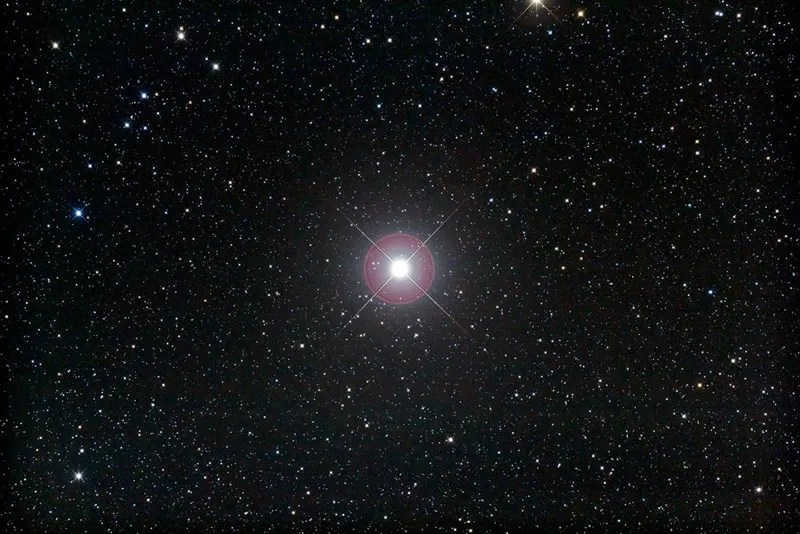
Pollux, the most brilliant star in the Gemini constellation. Picture: Fred Espanak
To conclude, it is worth mentioning that the visual perception of star colors is highly dependent on the sensitivity of our eyes and individual interpretation. One could argue and claim that Pollux appears as a deep orange, while Betelgeuse appears as a yellowish red. Conduct an experiment! Observe the stars listed in the table above with your own eyes and through an optical instrument. Give your own assessment of their colors!
What are the hues of stars?
If you take a close look on a cloudless night, you will be able to witness a multitude of vibrant stars in the sky. Have you ever pondered upon the factors that influence the shade of their flickering and what hues celestial stars possess?
The hue of a star is dictated by the temperature of its outer layer. The dispersion of luminous bodies, akin to precious gems, showcases an endless array of shades, resembling the magical palette of an artist. The higher the temperature of an object, the greater the energy of radiation emanating from its surface, consequently resulting in shorter wavelengths of emitted waves.
Even a slight variance in wavelength can alter the color perceived by the human eye. The longest wavelengths exhibit a red hue; as the temperature rises, it transforms into orange, then yellow, evolves into white, and eventually becomes white-blue.
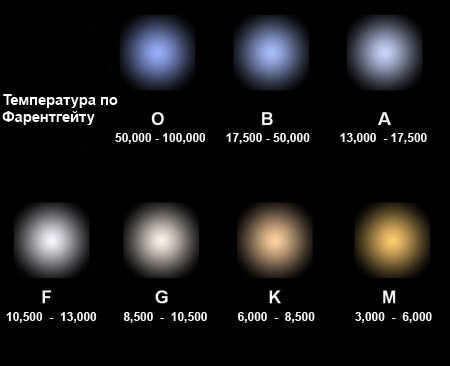
Blue stars
Within this category, there are newly formed stars that are embarking on their celestial journey. A prime example is Rigel, one of the primary stars in the Orion constellation, which emits a bluish-white hue.
Golden stars
Among the other celestial bodies that we are familiar with, there is a brilliant star known as Sirius. However, its true color is not easily visible to the naked eye. This is due to its relatively low position above the horizon, which causes its radiation to be heavily distorted by multiple refractions as it travels towards us. In regions with moderate latitudes, Sirius often appears to twinkle and can display the full spectrum of colors in just half a second!

